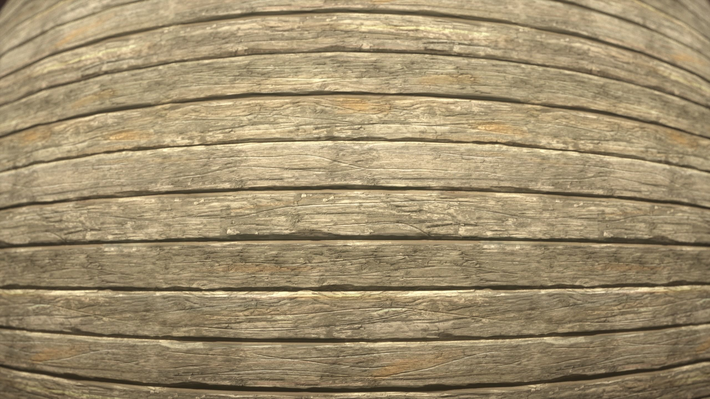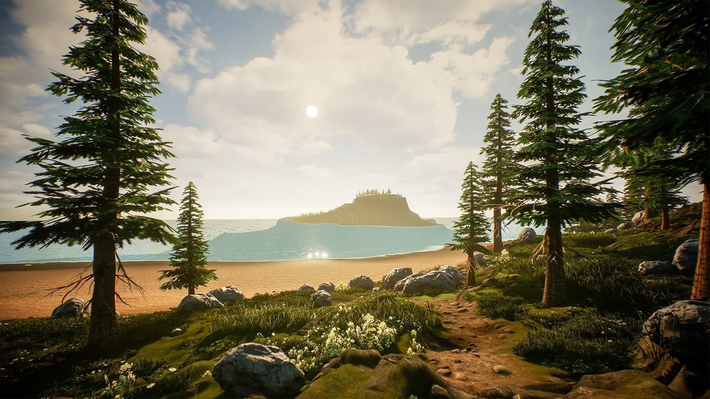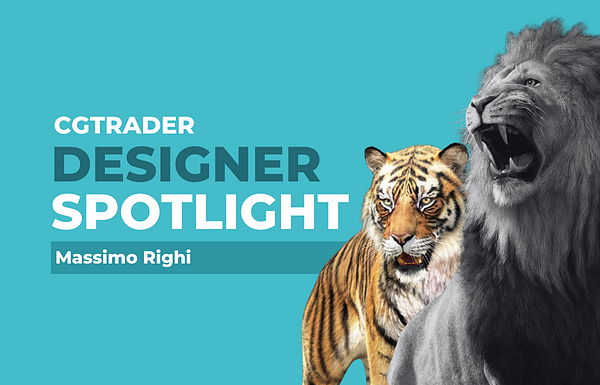There are 20 different categories of 3D models varying from food and interior to military and science on CGTrader. However, there are many 3D modeling related tools and things making 3D designer life easier that we simply cannot ignore those on our marketplace. We are happy to inform you that category Textures has been added to the growing list. Now you can browse through a library of beautifully-made materials and find the best suited, ready-to-use textures to prepare game-ready models, upgrade your asset library, and improve your 3D works.
Therefore, to learn more about the trends in the world of textures for 3D assets, we decided to talk with GameTextures, a 3D design company that can boast having one of the richest portfolio of textures on CGTrader. They say that having a 3rd party textures can save you from 1 to 3 days of production time and production cost. “I couldn't help but think that there just had to be a better way”, says the Founder of GameTextures. We invite you to read the full interview below, check what is available in this category already, and clean the dust off your own textures and upload to CGTrader.

1. Tell us more on who you are as a person and as the company?
We are Tanner Kalstrom and Arvin Villapando (or Arvin Moses as he’s known in the community). Founder and Product managers of GameTextures.com.
2. Why textures? How did you get started with GameTextures?
The initial idea of GameTextures happened in late 2011. I (Tanner) was up late one night texturing some environment assets for a freelance project and spending, yet, another night combing the internet looking for solid base textures to turn into materials. The sites I used were the usual ones, but I couldn't help but think that there just had to be a better way. With this idea as my primary motivation and some new tools for texture creation entering the market, I decided to scrape up every dollar I had in savings, recruit our first artist (Matt Dirks now our Lead Texture Artist) from the school I went to in Vancouver (www.tttc.ca), and we were off and running.
The first version of GameTextures took around 7 months of development - in which time Matt and I furiously started producing our initial library offering. It's hard to remember, but I think we created just shy of 800 fully tiled materials in those 7 months. I did some research and saw really nice results of people starting to build gloss maps for their textures, as well as people producing really nice Parallax Occlusion Materials, which were dependent on materials having a matching 16bit Height Map. So, I mean, it wasn't rocket appliances. We just tried to make things that would stay relevant for a few years. We had no idea how fortunate of a good decision that would prove to be.

3. Are these textures computer generated or hand-drawn?
We use a few different technologies to create our materials. Primarily we build them using Substance Designer, an incredible tool from our partners at Allegorithmic, to generate our materials. Although Designer is the primary “hub”, we use a variety of methods for generating texture maps. We’ll sculpt some height maps, blend in some photographs and even use some photogrammetry techniques depending on what the material demands. In the end, we try to find the best balance of quality, efficiency and control.

4. What are the three main advantages of using 3rd party textures in any project?
The most obvious advantage is speed and cost. Having a set of materials to choose from to quickly apply to a scene, prop, or a character you’re working on, saves an incredible amount of time. Building one material on average can take anywhere from 1 to 3 days. For each material you’re able to have on hand, instead of creating, you’ve saved about 1 to 3 days of production time and production cost.
The second is iteration and creative freedom. Although it would seem like building your own materials adds to your creative freedom, in some ways it actually hinders it. A great example is in creating a simple room. Having access to 3rd party textures allows you to quickly test what that room will look like with brick, plaster, or wood. You can quickly find out if your designs will work, or if they need adjustment. This leads to artists being able to more quickly experiment and test ideas, and ultimately create what they really want. We’ve had many situations where artists initially use our materials as place holders to get a feel for the room, but ultimately keep them in final passes.
Lastly, a great advantage is quality and consistency. There is a degree of specialization in material creation. At GameTextures, that’s what we specialize in. You know each time, you’re getting a finely tuned texture that’s PBR accurate, has all the necessary texture maps and that will have layers of control for variations. Being a substance based product allows us to not only craft accurate and realistic materials, but give our users controls to vary and tweak them to fit specific needs.

5. You are selling textures for quite a while. What specifics do you notice in this business?
Selling textures has gone through it’s shares of changes in the past few years. Initially, the market of textures would just be literal photographs. From there the market expanded to tileable textures. Finally, we started seeing full blown texture sets that could be used as materials. With the advent of PBR, the demand for quantity and quality has gotten bigger. Generating information from a single photograph is typically too inaccurate for PBR so scan-based, or handcrafted definitely rise to the forefront. There’s also a growing need for larger and larger libraries, both in sheer quantity as well as the variety of available materials.

6. What main trends do you see in CG field these days?
Wow the scope is so big of current CG trends… Perhaps we can start with things that directly interest us. Trends in open interchange formats, such as MaterialX by ILM, which is a big deal. These technologies are important to us as developers to make accessibility easier for our end users.
VR is obviously an important trend right now. We’ve had the incredible privilege of being acknowledged by many VR developers as VR ready and used in projects like Robo Recall, Golem, and Hotdogs Horseshoes and Hand Grenades. It’s a brand new world for VR with new specifications about how assets need to be defined for a truly unique way of visualization. It’s pretty cool, because in some ways it’s a brave new world, again, with new capabilities and limitations to figure out. Real time is interesting. Unity’s partnership with Octane and Unreal’s partnership with VRay is something we’re definitely watching. The gap between real-time and offline rendering are getting smaller and smaller. It’s definitely an exciting time to be a part of CG.

7. What is your next big project or challenge you want to complete?
A new website! We’re currently working on a new site which we are extremely excited about. We can’t talk about the specifics yet, but there will be some new tools for users that we can’t wait to reveal.
Product wise, we are trying to broaden our library. Most of our materials are currently geared toward environments and props, and we are looking to add some products and tools geared toward character work, stylized textures and other experiments. One thing I think we can mention is that we are very soon adding an alpha and height library.

8. Why did you decide to start selling on CGTrader?
We were looking into different avenues to sell our products. GameTextures is subscription based and it really works well for us. However, we know that there is a large user-base out there that just need a quick purchase for specific projects on short deadlines. CGTrader seemed like the perfect place for us to expand in this way. The site is blazing fast, the revenue share is extremely fair and it was really easy to work with the staff. It’s been a very fun and exciting ride thus far and we’re looking forward to continue to work with CGTrader in the future.

9. You state that you live by three rules in your work: 1) always be dreaming, 2) be inspired by your workplace, and 3) make awesome art. Can you think of some most recent examples of these rules seen in everyday life? Any new developments?
As far as always dreaming - dreaming might be one of the most important things we do at GameTextures. Man, this reaches everything from our next step in business to our product lines, to what type of textures we are building. One great example: someone asked us for a stylized water texture. Our first response was that water is generally handled by the shader, not texture information. Our lead artist, Matt Dirks, offered to take a stab at it and now it’s actually our 2nd highest downloaded material of all time.
Be Inspired by your workplace. This one is interesting in that we’re all remote. We’ve had to get very creative by trying to figure out ways to connect and stay mutually motivated even though we aren’t in the same physical space. We try to have fun things to do as a team, like play different games together. One of the things that have been really fun for us is our GameTextures livestream. Arvin or a guest artist typically runs the stream and the rest of us field questions and interact with the community. This year, we’ve rented a booth at Austin Game Convention and this is the first time our all team is getting to hangout. Between that and hanging out with guys in the GT community, we’re really excited.
Make awesome art. This is one that we recently had to deal with. As I have mentioned, we’re rebuilding the website, and one of the choices we had to make was whether to flood the site with marketing, calls to action and features or take a more artistic approach and let the work speak for itself. In the end, we found the art was the most important. So, we tried to let it speak. At the end of the day, it’s the art that motivates us and that’s what keeps pushing us forward.
Thank you to CGTrader for allowing us an awesome interview and Justas for being patient with our response.
Thank you for the time.












Comments